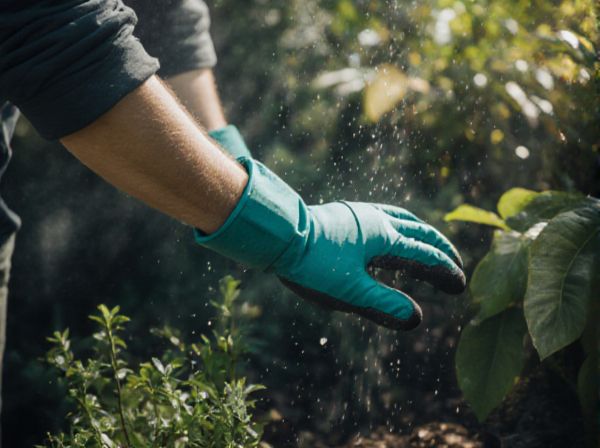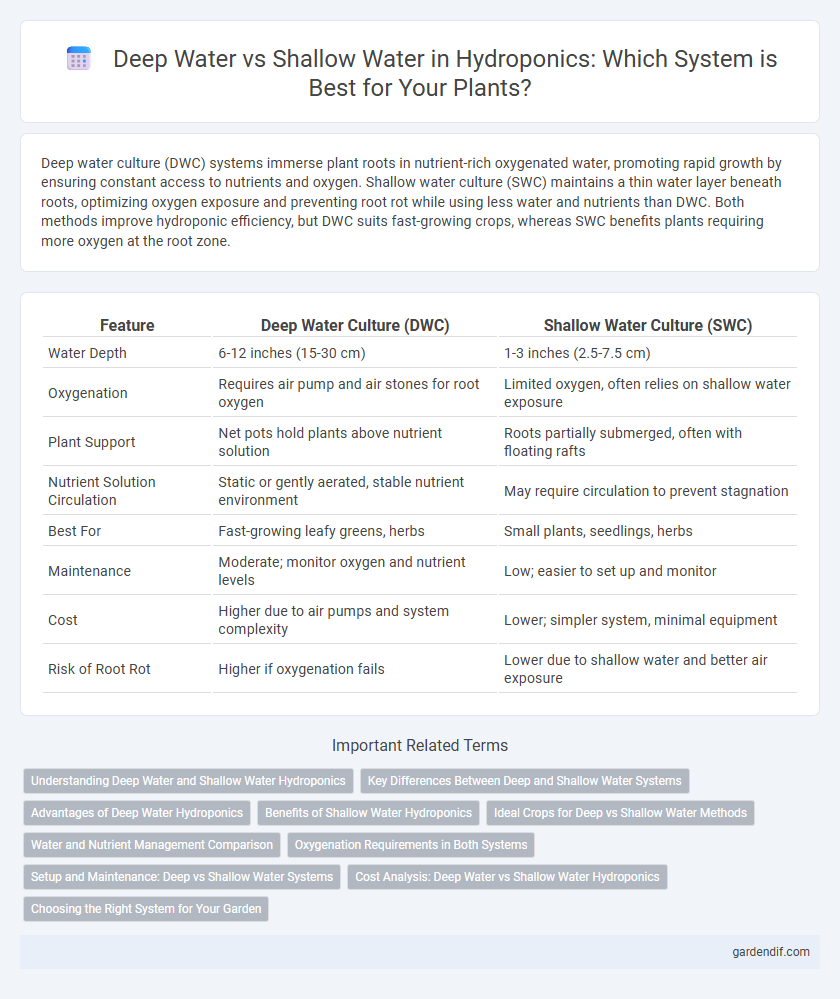
Deep Water vs Shallow Water Illustration
Deep water culture (DWC) systems immerse plant roots in nutrient-rich oxygenated water, promoting rapid growth by ensuring constant access to nutrients and oxygen. Shallow water culture (SWC) maintains a thin water layer beneath roots, optimizing oxygen exposure and preventing root rot while using less water and nutrients than DWC. Both methods improve hydroponic efficiency, but DWC suits fast-growing crops, whereas SWC benefits plants requiring more oxygen at the root zone.
Table of Comparison
| Feature | Deep Water Culture (DWC) | Shallow Water Culture (SWC) |
|---|---|---|
| Water Depth | 6-12 inches (15-30 cm) | 1-3 inches (2.5-7.5 cm) |
| Oxygenation | Requires air pump and air stones for root oxygen | Limited oxygen, often relies on shallow water exposure |
| Plant Support | Net pots hold plants above nutrient solution | Roots partially submerged, often with floating rafts |
| Nutrient Solution Circulation | Static or gently aerated, stable nutrient environment | May require circulation to prevent stagnation |
| Best For | Fast-growing leafy greens, herbs | Small plants, seedlings, herbs |
| Maintenance | Moderate; monitor oxygen and nutrient levels | Low; easier to set up and monitor |
| Cost | Higher due to air pumps and system complexity | Lower; simpler system, minimal equipment |
| Risk of Root Rot | Higher if oxygenation fails | Lower due to shallow water and better air exposure |
Understanding Deep Water and Shallow Water Hydroponics
Deep Water Hydroponics (DWC) involves suspending plant roots in a nutrient-rich, oxygenated water solution, promoting rapid growth and efficient nutrient uptake. Shallow Water Culture (SWC) uses a thin layer of nutrient solution beneath the roots, providing stable oxygen levels while minimizing water usage. Understanding the oxygenation methods and root zone environment in both systems is crucial for optimizing plant health and maximizing yield in hydroponic cultivation.
Key Differences Between Deep and Shallow Water Systems
Deep Water Culture (DWC) systems submerge plant roots in oxygen-rich nutrient solution at depths typically between 6 to 12 inches, promoting faster growth and higher yields due to efficient oxygen and nutrient absorption. Shallow Water Culture (SWC) systems maintain roots in a nutrient solution depth of 1 to 3 inches, offering better control over root temperature and lower oxygenation requirements, which reduces energy costs. The key differences lie in root immersion depth, oxygenation levels, and system complexity, influencing overall plant growth and resource efficiency.
Advantages of Deep Water Hydroponics
Deep Water Hydroponics (DWC) offers superior oxygen availability to plant roots through constant submersion in oxygen-rich nutrient solution, promoting faster growth and higher yields. The stable water environment in DWC systems reduces nutrient fluctuations and stress, enhancing plant health and minimizing root diseases common in shallow water setups. Its efficiency in nutrient uptake and ease of automation make DWC a preferred choice for commercial hydroponic farming.
Benefits of Shallow Water Hydroponics
Shallow water hydroponics offers enhanced oxygenation to plant roots due to the reduced water depth, promoting faster nutrient uptake and growth. This method conserves water and nutrients efficiently, leading to lower operational costs and minimal waste. Its simplicity and ease of maintenance make it ideal for small-scale and urban gardening applications, ensuring consistent crop yields year-round.
Ideal Crops for Deep vs Shallow Water Methods
Deep water culture (DWC) excels with larger, fast-growing crops such as lettuce, basil, and spinach due to their need for ample oxygen and nutrient access. Shallow water culture suits smaller or slower-growing plants like strawberries, herbs, and microgreens, benefiting from a more controlled root zone environment. Choosing the appropriate hydroponic method depends on the crop's root density, growth rate, and oxygen requirements for optimal yield.
Water and Nutrient Management Comparison
Deep Water Culture (DWC) systems submerge plant roots in oxygenated nutrient-rich water, enabling continuous access to essential nutrients and reducing the risk of nutrient depletion compared to Shallow Water Culture (SWC). Shallow Water Culture requires more frequent monitoring and adjustment of nutrient concentrations due to limited water volume, which can lead to quicker nutrient imbalances. Oxygenation levels are generally higher and more stable in DWC, promoting better root health and nutrient uptake efficiency than in SWC setups.
Oxygenation Requirements in Both Systems
Deep water culture systems require consistent oxygenation through air stones or diffusers to maintain dissolved oxygen levels around 6-8 mg/L, essential for healthy root respiration and nutrient uptake. Shallow water culture offers lower oxygen demand but still benefits from mild aeration to prevent stagnant conditions and root hypoxia, typically maintaining dissolved oxygen near 4-6 mg/L. Efficient oxygenation in both systems directly influences plant growth rates, root health, and overall crop yield in hydroponic cultivation.
Setup and Maintenance: Deep vs Shallow Water Systems
Deep water systems require sturdy containers with oxygenation devices like air pumps to maintain nutrient-rich water, ensuring plant roots remain submerged yet oxygenated. Shallow water systems feature trays or channels with thin nutrient films that demand less water and simpler setups but require regular monitoring to prevent drying and nutrient imbalances. Maintenance for deep systems involves occasional water changes and equipment checks, while shallow systems need more frequent inspections to sustain optimal flow and nutrient levels.
Cost Analysis: Deep Water vs Shallow Water Hydroponics
Deep Water Culture (DWC) systems generally incur higher initial costs due to the need for large reservoirs, durable air pumps, and extensive water circulation equipment, while Shallow Water Culture (SWC) systems tend to be more budget-friendly with simpler designs and lower material expenses. Operating costs for DWC may increase over time because of higher energy consumption related to continuous aeration and water movement, whereas SWC systems typically require less power, reducing long-term utility expenses. Cost efficiency in hydroponics depends on scale and crop type, with DWC favoring high-yield, deep-rooted plants justifying investment and SWC suitable for cost-sensitive, smaller-scale operations.
Choosing the Right System for Your Garden
Deep Water Culture (DWC) systems maintain plant roots suspended in nutrient-rich oxygenated water, providing rapid growth and high yield for larger plants or commercial setups. Shallow Water Culture (SWC) uses a thinner layer of water, making it ideal for smaller plants, seedlings, or home gardens with limited space, offering easier maintenance and lower water usage. Selecting between DWC and SWC depends on plant size, growth rate requirements, available space, and user experience to optimize nutrient delivery and oxygenation.
Deep Water vs Shallow Water Infographic

 gardendif.com
gardendif.com